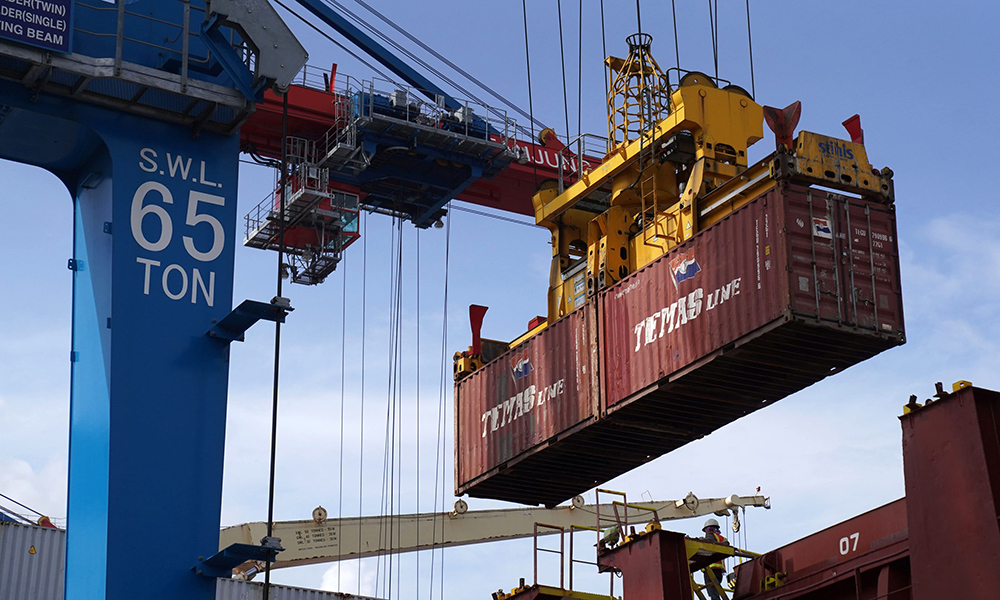
终于,美国的供应短缺和送货延迟现象开始有所缓解,但大部分美国人对船运公司和联邦政府的指责愈演愈烈,抱怨他们无能,让消费者买不到想买的东西。
美国Morning Consult公司在11月对2200名消费者进行了一项调查。12月16日,调查结果公布,约58%的受调查者认为,运输和物流公司对目前供应链瓶颈导致的供应短缺应该承担“主要”或“部分”责任;而认为这一后果应该归咎于政府的受调者占比达55%,二者比例差不多。

实际上,供应链是一个十分复杂的系统,而且大部分情况下都具有全球性。因此,一旦供应链出现问题,仅一方犯错的情况是非常罕见的。今年,为解决供应链问题,乔·拜登政府已经采取了几项措施,包括保持港口全天候开放、与商界领袖会谈,甚至建议用国民警卫队进行卡车运输(白宫后来表示,目前尚未积极落实最后这项措施)。
专家表示,新冠疫情的影响还未完全消失,而消费者被压抑的购物欲望和需求已经释放,产生了一场完美风暴,因而给当前的供应链带来了各种挑战。美国外交关系委员会(Council on Foreign Relations)的著名研究员迈克尔·斯宾塞写道:“尽管消费需求增加了,但新冠疫情仍然对主要港口和制造商存在影响,使其运作缓慢,拉低了供应效率。”
在新冠疫情期间,许多美国人疯狂购买电子产品、家庭健身器材和乐器。随后新冠疫苗面世,消费势头更是未见减缓。
与此同时,供应链上的许多行业,例如制造业、船运、交通运输,甚至零售业,都仍然处于新冠疫情阴影的笼罩之下,纷纷出现工人短缺、交货延误和成本飙升等问题。
制造商不得不提高产量以满足市场需求,但又给负责原材料运输的公司带来了压力。与此同时,船运集装箱开始出现短缺,成品堆积如山,运输成本飙升。美国外交关系委员会的数据显示,今年9月,从中国运送一个集装箱到美国,运费高达2万美元。而2020年2月,只需1500美元。
归根结底,消费性开支激增引发的多米诺骨牌效应,使整个供应链系统瘀滞不前。虽然新冠疫情的爆发是主要原因,但企业对精益库存和即时库存技术的依赖,也是原因之一:企业精简库存后,如果需求飙升或供应链出现问题,就可能出现供应短缺的情况。
更糟的是,在新冠疫情初期,一些航运公司预料到消费者对其业务的需求会下降,所以降低了航行频次。还有,一些国家及其政府已经出台了交通限制措施,来遏制新冠疫情的扩散,这也不利于制造业和航运的发展。
经济学家严正指出,以上问题的持续存在,导致了美国通胀率的上升。根据最新的消费者价格指数,美国的消费品和服务价格在过去一年里上涨了6.8%。
尽管情况严峻,但未来也将听到一些好消息。专家预测,直到明年年初,供应链瓶颈都将持续以某种形式存在。然而,情况可能会于明年下半年趋于平稳。法国信用保险公司裕利安怡(Euler Hermes)在上周的一份报告中表示,全球供应链中断的情况将持续到2022年下半年。但该公司也预测,明年全球贸易将增长5.4%。
当然,由于奥密克戎变异毒株和其它未来可能出现的变异毒株,不确定因素依然存在。一些毒株可能还对新冠疫苗产生抗药性。美联储(Federal Reserve)的主席杰罗姆·鲍威尔在12月15日说:“不确定因素非常多。然而其会对经济产生何种影响,将取决于在多大程度上抑制需求,而非抑制供应。”
鲍威尔称,研究表明,新冠疫苗和加强针可以有效防护目前的变异毒株,因此接种新冠疫苗的人越多,新冠疫情对经济的影响就越低。然而,这并不意味着影响为零。他说:“德尔塔毒株减缓了用人招聘的速度,切实对全球供应链产生了影响,妨害其正常运转。因此,奥密克戎毒株应该也会对经济产生不良影响。然而在我看来,这种不良影响目前还未充分显露。”(财富中文网)
译者:Transn
终于,美国的供应短缺和送货延迟现象开始有所缓解,但大部分美国人对船运公司和联邦政府的指责愈演愈烈,抱怨他们无能,让消费者买不到想买的东西。
美国Morning Consult公司在11月对2200名消费者进行了一项调查。12月16日,调查结果公布,约58%的受调查者认为,运输和物流公司对目前供应链瓶颈导致的供应短缺应该承担“主要”或“部分”责任;而认为这一后果应该归咎于政府的受调者占比达55%,二者比例差不多。
实际上,供应链是一个十分复杂的系统,而且大部分情况下都具有全球性。因此,一旦供应链出现问题,仅一方犯错的情况是非常罕见的。今年,为解决供应链问题,乔·拜登政府已经采取了几项措施,包括保持港口全天候开放、与商界领袖会谈,甚至建议用国民警卫队进行卡车运输(白宫后来表示,目前尚未积极落实最后这项措施)。
专家表示,新冠疫情的影响还未完全消失,而消费者被压抑的购物欲望和需求已经释放,产生了一场完美风暴,因而给当前的供应链带来了各种挑战。美国外交关系委员会(Council on Foreign Relations)的著名研究员迈克尔·斯宾塞写道:“尽管消费需求增加了,但新冠疫情仍然对主要港口和制造商存在影响,使其运作缓慢,拉低了供应效率。”
在新冠疫情期间,许多美国人疯狂购买电子产品、家庭健身器材和乐器。随后新冠疫苗面世,消费势头更是未见减缓。
与此同时,供应链上的许多行业,例如制造业、船运、交通运输,甚至零售业,都仍然处于新冠疫情阴影的笼罩之下,纷纷出现工人短缺、交货延误和成本飙升等问题。
制造商不得不提高产量以满足市场需求,但又给负责原材料运输的公司带来了压力。与此同时,船运集装箱开始出现短缺,成品堆积如山,运输成本飙升。美国外交关系委员会的数据显示,今年9月,从中国运送一个集装箱到美国,运费高达2万美元。而2020年2月,只需1500美元。
归根结底,消费性开支激增引发的多米诺骨牌效应,使整个供应链系统瘀滞不前。虽然新冠疫情的爆发是主要原因,但企业对精益库存和即时库存技术的依赖,也是原因之一:企业精简库存后,如果需求飙升或供应链出现问题,就可能出现供应短缺的情况。
更糟的是,在新冠疫情初期,一些航运公司预料到消费者对其业务的需求会下降,所以降低了航行频次。还有,一些国家及其政府已经出台了交通限制措施,来遏制新冠疫情的扩散,这也不利于制造业和航运的发展。
经济学家严正指出,以上问题的持续存在,导致了美国通胀率的上升。根据最新的消费者价格指数,美国的消费品和服务价格在过去一年里上涨了6.8%。
尽管情况严峻,但未来也将听到一些好消息。专家预测,直到明年年初,供应链瓶颈都将持续以某种形式存在。然而,情况可能会于明年下半年趋于平稳。法国信用保险公司裕利安怡(Euler Hermes)在上周的一份报告中表示,全球供应链中断的情况将持续到2022年下半年。但该公司也预测,明年全球贸易将增长5.4%。
当然,由于奥密克戎变异毒株和其它未来可能出现的变异毒株,不确定因素依然存在。一些毒株可能还对新冠疫苗产生抗药性。美联储(Federal Reserve)的主席杰罗姆·鲍威尔在12月15日说:“不确定因素非常多。然而其会对经济产生何种影响,将取决于在多大程度上抑制需求,而非抑制供应。”
鲍威尔称,研究表明,新冠疫苗和加强针可以有效防护目前的变异毒株,因此接种新冠疫苗的人越多,新冠疫情对经济的影响就越低。然而,这并不意味着影响为零。他说:“德尔塔毒株减缓了用人招聘的速度,切实对全球供应链产生了影响,妨害其正常运转。因此,奥密克戎毒株应该也会对经济产生不良影响。然而在我看来,这种不良影响目前还未充分显露。”(财富中文网)
译者:Transn
Product shortages and delivery delays are finally easing up, but many Americans increasingly blame shipping companies and the federal government for their inability to get their hands on the products they want.
About 58% of consumers say shipping and logistics companies bear “a lot” or “some” of the blame for the current supply chain bottlenecks that have led to shortages, according to Morning Consult’s survey of 2,200 consumers fielded in November and published on December 16. But nearly as many Americans, 55%, blame the government.
In fact, supply chains are complex and, in many cases, are global—which means there’s rarely one entity to blame when things go wrong. The Joe Biden administration has taken several steps this year to help fix supply chain problems, including keeping ports open 24/7, meeting with business leaders, and even supporting a National Guard deployment to reduce trucking shortages (the White House later said it wasn’t actively pursuing this option at the moment).
Experts say that the current supply chain challenges are a result of a perfect storm of pent-up consumer demand being unleashed before the effects of the pandemic had truly passed. “As demand increased, pandemic-related disruptions continued to affect major ports and manufacturing facilities, dampening the supply response,” writes Michael Spence, a distinguished fellow with the Council on Foreign Relations.
During the pandemic, many Americans went on a shopping spree for electronics, home workout gear, and musical instruments. And they have continued their spending after vaccines became available.
Meanwhile, many industries along the supply chain—manufacturing, shipping, transportation, and even retail—were dealing with COVID outbreaks, worker shortages, delays, and soaring costs.
Manufacturers eventually ramped up production to meet demand, but that put pressure on companies responsible for transporting raw materials. At the same time, shipping containers became scarce, and finished products piled up. And then transportation costs soared. Shipping a container from China to the U.S., for instance, hit $20,000 in September, compared with just $1,500 in February 2020, according to the Council on Foreign Relations.
Bottom line, the spike in consumer spending created a domino effect that clogged the system. While the pandemic played a significant role, corporations’ reliance on lean and just-in-time inventory techniques to limit their costs likely also played a part. These approaches mean companies store less inventory, which can lead to supply shortages if demand soars or if there are supply chain issues.
It also didn’t help that some shipping companies, at the beginning of the pandemic, reduced their schedules, anticipating a drop in consumer demand. Or that some countries and governments have put restrictions in place to contain COVID-19 outbreaks that also impact manufacturing and shipping.
Economists have blamed these ongoing issues as contributing to rising U.S. inflation rates. The price of U.S. consumer goods and services rose 6.8% over the past year, according to the latest consumer price index.
But there is some good news ahead. Experts predict that supply chain constraints will continue in some form or another through early next year, but likely level off during the second half. In a report last week, credit insurance company Euler Hermes said global supply chain disruptions will remain high until the second half of 2022, but it expects global trade to grow 5.4% next year.
There is, of course, uncertainty about the impact of Omicron and any future COVID-19 variants, some of which are expected to be vaccine-resistant. “There’s a lot of uncertainty,” Fed Chair Jerome Powell said on December 15. “What’s going to be the effect on the economy? That will depend on how much it suppresses demand as opposed to suppressing supply.”
Currently, research shows that vaccines and boosters work against the current COVID variants, so the more people who get vaccinated, the lower the economic effect, Powell said. But this doesn’t mean there won’t be any economic repercussions. “Delta had an effect of slowing down hiring, and it actually had an effect on global supply chains. And that hurt the process of the global supply chains getting worked out. So [Omicron] can have an economic effect. I just think at this point, we don’t know much,” Powell said.






